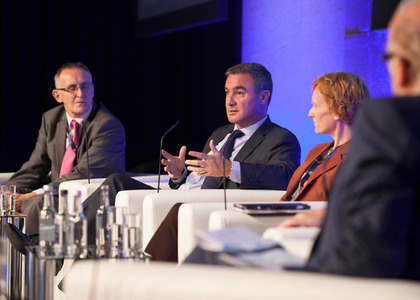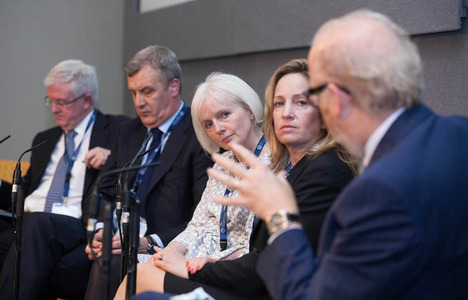- Latest Edition April 17th: Tariffs on aircraft - delay and hope
- April 3rd Edition: Avoiding tariff turbulence
- March 20th Edition: How tariffs could reshape the aircraft market
- March 6th Edition: The possible slowdown in international air travel
- February 20th Edition: Momentum builds in 2025's ABS market
- February 6th Edition: Optimism on aircraft supply, but bottlenecks remain
|
The future of the global aircraft leasing industry analysed by leaders in Dublin
Leaders of the aviation finance industry participated in a set of three panels during the Financial Centres Summit 2017 held in Dublin, Ireland on October 17th. The leaders gave their insights into the condition of the aircraft financing market currently and the prospects in the years ahead.
A number of clear themes emerged during the discussions;
- Demand for commercial aircraft continues to grow and that lays down the foundations for further expansion in the aircraft leasing sector. Having lifted the share of aircraft accounted for by leasing from 5% in the 1970s to over 45% currently the market is set grow further as leasing retains its attractions to airlines worldwide. This optimistic outlook for overall aircraft demand is key to understanding the strong pace of investment behind a variety of existing and new aircraft leasing platforms worldwide.
- Asian capital is a major contributor to aircraft leasing development currently. The absolute scale of Asian economies, and especially China, is not reflected in its share of the global aircraft financing market. This is changing quickly as financial institutions in China and other Asia-Pacific countries allocate increased resources to establishing a position in air finance that reflects their economies and the fast developing scale of their aviation industries. This increased level of interest is being converted in to opportunities for all new aircraft leasing companies and for existing businesses seeking investors to expand in Asia. - New technology aircraft programmes are evolving well despite technical setbacks. Although the A320NEO programme has been affected by well versed engine issues, the attending lessors expressed confidence that these would be resolved by the OEMs involved. The experience of previous programmes, and particularly the Boeing 787, were advanced as precedents in this regard. The 787 encountered material technical issues at the beginning of its life but has since resolved these and evolved in to a high performing asset that is meeting and exceeding both operational and financial metrics set out by Boeing at the outset. Lessors see the Boeing MAX, Airbus A350, A330NEO, A320NEO and Boeing 777X in a similar vein and argued all of these aircraft offer significant potential for both users and investors in the decades ahead. In addition, the panels did not forsee any major challenge in integrating new and existing technology aircraft in their portfolios. Current generation aircraft are set to perform well for an extended period as it will take many years before new technology aircraft assume critical assume in their targeted short and long haul categories worldwide. - Demand in developing markets remains a key driver of aircraft. Ground level demand for both passenger and freight in developing markets is outpacing GDP rates in those areas and economic growth is ahead of global averages. That dynamic is creating a fast growing market for aircraft and airlines are preparing for such growth by expanding their fleets rapidly. This environment creates a rich opportunity for lessors to deploy both current and new technology equipment and provides confidence in concluding orders for new aircraft in the years ahead. - Liquidity is strong in aircraft financing. A combination of QE, low interest rates and the continuing solid performance of aircraft assets is creating significant liquidity for aircraft leasing. While this is creating some risk of overheating for certain asset classes it is providing ample supply of capital to grow existing platforms or establish new companies in the air finance market. It was suggested that an unwinding of QE and rising interest rates will create its own challenges. However, lease rates tend to follow interest rates so any increase in headline money rates will probably lead to higher lease rates over time.
- Young short-haul aircraft are the sweet spot of demand among aircraft investors. Short-haul young aircraft continue to be the most sought after asset by newly established leasing companies. A broad range of users, a deep market and evidence of long term financial returns makes aircraft such as the Boeing 737 and Airbus A320 families assets of choice among developing and existing lessors. In contrast large wide body aircraft are more challenging to manage as they tend to have narrower user bases and are relatively large unit size capital consumers. Despite these attributes aircraft such as the A330, A350 and B777 are valued components of many aircraft leasing portfolios. - New centres are targeting aircraft finance as a business of opportunity. Given the success of aircraft leasing as a growing sub-set of the financial services industry a number of jurisdictions are competing hard to attract investment in the sector. Centres such a Hong Kong and Singapore are actively enticing leasing investors to consider their locations instead of established centres such as Ireland. This is creating a competitive tension which needs to be considered by policymakers that are seeking to retain or attract this vibrant sector. - Ireland should explore ways to broaden its capital market capabilities around aircraft assets. Ireland has established itself as the global leader for aircraft leasing platforms but it was argued more needs to be done to broaden its strengths in this market. In particular the idea of developing a stronger capital markets capability in Ireland was seen as one avenue that could help further develop air finance competitiveness. If Ireland can create the ability to originate and distribute capital market transactions for aircraft assets it would augment its leadership position in aircraft leasing. - The Airbus purchase of Bombardier provides an opportunity for the C Series to develop a broader customer base. The Airbus deal to acquire a share of the C Series programme was announced on the morning of the Summit. It is considered a move that could give the C Series much needed energy by providing after market support and a sales infrastructure which help convince airline and leasing customers of its merits. Although it was agreed the C Series was an engineering success the ability to combine it with the strengths of the Airbus eco-system provided a framework is which the programme could gather some additional momentum. - The overall tone of the panels was one of optimism about the future of the aircraft leasing sector, albeit with a variety of challenges and opportunities that will change the structure and composition of this ever dynamic industry in the years ahead. |


